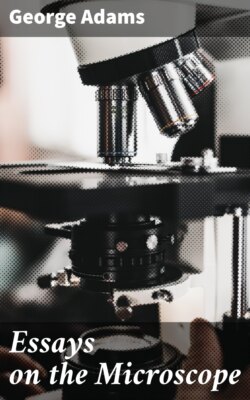Читать книгу Essays on the Microscope - George Comp Adams - Страница 52
На сайте Литреса книга снята с продажи.
DESCRIPTION OF THE VARIOUS PARTS OF THE MICROSCOPE.
ОглавлениеK, the box which contains the whole apparatus; it is generally made of fish-skin; on the top of the box there is a female screw, for receiving the screw which is at the bottom of the brass pillar A, and which is to be screwed on the top of the box, K. D, a brass pin which fits into the pillar; on the top of this pin is a hollow socket to receive the arm which carries the magnifiers; the pin is to be moved up and down, in order to adjust the lenses to their focal or proper distance from the object.
In the representation of this microscope, Plate VII. B. Fig. 1, the pin, D, is delineated as passing through a socket at one side of the pillar, A; it is now usual to make it pass down a hole bored through the middle of the pillar.
E, the bar which carries the magnifying lens; it fits into the socket, X, which is at the top of the pillar, D. This arm may be moved backwards and forwards in the socket X, and sidewise by the pin, D; so that the magnifier, which is screwed into the ring at the end, E, of this bar, may be easily made to traverse over any part of the object lying on the stage or plate B. F is a polished silver speculum, with a magnifying lens placed at the center thereof, which is perforated for this purpose. The silver speculum screws into the arm E, as at F. G, another speculum of a different concavity from the former, with its lens. H, the brass semicircle which supports the mirror, I; the pin, R, affixed to the semicircle, H, passes through the hole which is towards the bottom of the pillar, A. B, the stage or the plane on which the objects are to be placed; it fits into a small dove-tailed arm which is at the upper end of the pillar, A. C, a plane glass, with a small piece of black silk stuck on it; this glass is fitted to a groove made in the stage, B. M, a deep concave glass, to be laid occasionally on the stage instead of the plane glass, C. L, a pair of nippers; these are fixed to the hole of the stage, a, by the pin K; the steel wire of these nippers slides backwards and forwards in the socket, and this socket is moveable upwards and downwards by means of the joint, so that the position of the object may be varied at pleasure. The object may be fixed in the nippers, stuck on the point, or affixed by a little gum-water, &c. to the ivory cylinder, N. O, a small pair of brass forceps to take up minute objects by. P, a brush to clean the glasses.
To use this microscope; begin by screwing the pillar, A, to the cover thereof; pass the pin, R, of the semicircle which carries the mirror through the hole that is near the bottom of the pillar, A; push the stage into the dove-tail at B; slide the pin into the pillar, then pass the bar, E, through the socket, X, which is at the top of the pin D, and screw one of the magnifying lenses into the ring at F.
Now place the object either on the stage, or in the nippers L, and in such a manner, that it may be as nearly as possible over the center of the stage; bring the speculum, F, over the part you mean to observe; then get as much light on the speculum as you can, by means of the mirror, I; the light received on the speculum is reflected by it on the object. The distance of the lens, F, from the object is regulated by moving the pin, D, up and down, until a distinct view of it is obtained. The rule usually observed is, to place the lens beyond its focal distance from the object, and then gradually slide it down, till the object appears sharp and well defined. The adjustment of the lenses to their foci, and the distribution of the light on the object, are what require the most attention.
These microscopes are sometimes fitted up with a rack and pinion to the pillar A, and pin D, for the more ready adjustment of the glasses to their proper foci.
